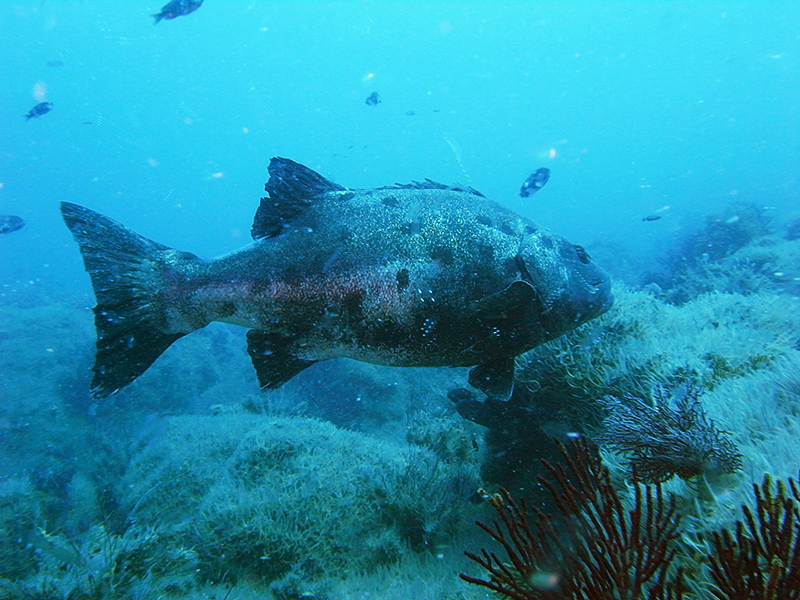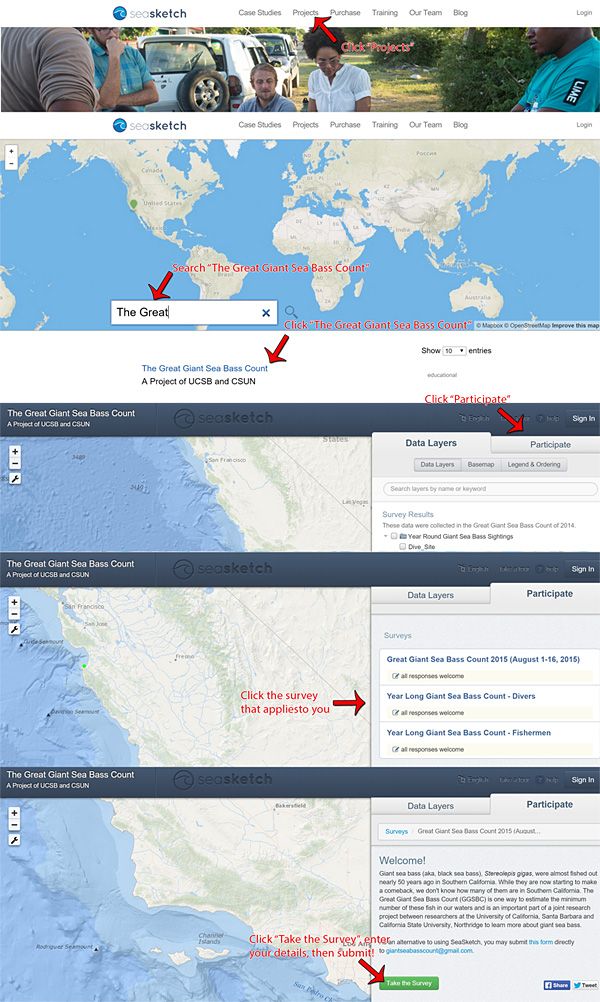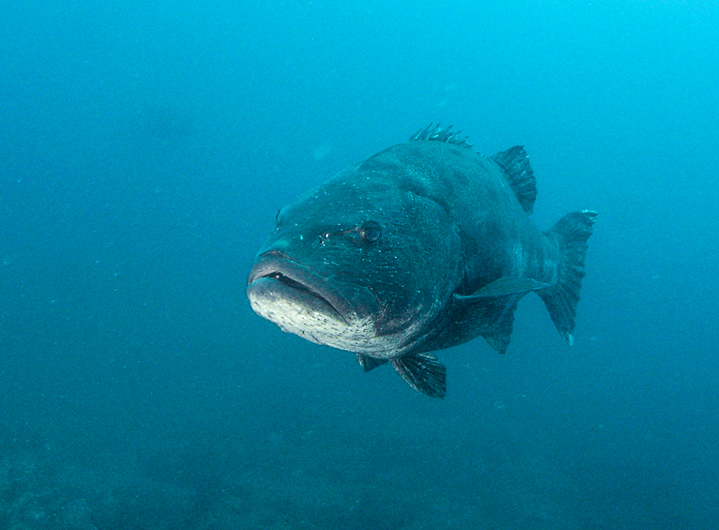The Giant Sea Bass

The Giant Sea Bass Count
Written by Kristiana Rendón
The giant sea bass or black sea bass (Stereolepis gigas) are magnificent marine creatures because of their enormous size and long life span. They have many other interesting characteristics which you can learn more about in Megumi Itoh’s article posted below. Giant sea bass used to be an abundant species in the Southern California waters until the 1980s. Due to overly frequent commercial and sport fishing, they are considered a dying species, close to extinction. However, scientists and all divers can work together as a team to help improve the giant sea bass population and it is literally as easy as counting 1, 2, 3!
The team at SeaSketch has designed an intuitive system where divers can be citizen scientists simply be reporting the number of giant sea bass they saw or did not see. Any data that is reported to scientists is helpful even though none were spotted because they still provide information about their population. Additionally, having more reports from volunteer divers offer researchers more data to work with. You can send in your giant sea bass siting report in the following easy steps (below includes a picture guide as well).
Go to SeaSketch’s projects page (http://www.seasketch.org/projects/)
In the search bar, enter “The Great Giant Sea Bass Count”.
Click on the tab on the right that says “Participate”.
Click on whichever survey applies to you.
Click “Take the Survey”.
Enter the details from the site to the best of your abilities. If you can’t fill them all in, it’s ok. Remember some data are better than no data.
Double check your entry and click “Submit Reponses”. And you’re done! You just helped scientists get one step closer to saving the giant sea bass!
Now you can submit your giant sea bass count on the SeaSketch survey whenever you go out on your next dive. This time of year (August) is the giant sea bass’ mating season, so it’s the perfect opportunity to gather data. Let’s go out there and start counting!

Marine Life – Giant Sea Bass
Written by Megumi Itoh
Giant sea bass (Stereolepis gigas), also known as black sea bass and jewfish, are the largest fish we see in the California’s kelp forest. They are described as having bulky body with large head and mouth, low profile spiny dorsal (fore-dorsal) fin, taller soft dorsal (rear dorsal) fin, flat tail, and large dark spots over dark brown to gray body. However, you don’t really need to depend on this description to identify them. You will not mistake these massive fish for any other fish. They are rather ugly looking, but I would say they the most majestic fish we see in the local waters. They are simply massive and they move with such confident gentleness.
They are apex predator fish. When fully grown, their only predators are great white shark and people. According to the California Department of Fish and Wildlife’s Marine Sportfish Identification, they can grow to be over 7 feet long and weigh over 500 pounds. They range from Humboldt Bay, California to Baja California, Mexico, and Gulf of California. They aggregate mainly south of Point Conception in the 35 to 130 feet range, in the kelp beds with rocky bottoms near drop-offs.
Aquarium of the Pacific in Long Beach, California has three giant sea bass in captivity (they have a special permit from the California Department of Fish and Wildlife). The two larger fish are male and female estimated to be around 30 years old, and the third is presumed to be a young male based on its behavior pattern. They live to be at least 50 years old, and they sexually mature in 10 to 13 years. The oldest known specimen was 72 years old. Their mating season is from June to September. This is when the divers most often see them in large aggregation.
I have learned a few surprising facts about this fish when I did my research for this article. The juveniles look drastically different from the adults and are often mistaken for other fish species. The juvenile’s body shape is more perch-like, and the color is sandy red to orange with white spots and irregular dark patches. They are found in the kelp beds and sandy bottoms at a shallower depth than the adults. The other surprising fact is that the adults have the ability to change the appearance of the dark spots on their body at will. It is believed that they use this ability to communicate stress and other signals to other giant sea bass in the area. This explains why sometimes the spots look distinctive and at other times they are barely visible.
These fish were once abundant in California, but they were hunted to near extinction. According to the 2008 Status of Fisheries Report by the Department of Fish and Wildlife, commercial fishing of giant sea bass began in 1870 in southern California, peaking in 1932. Recreational fishing began in 1895, and peaked in California in 1964 and in Mexico in 1973. Both commercial and recreational fishing were banned in 1981, but a loophole in the law allowed for their continued hunting. Commercial gill net and trammel net fisheries were allowed to take two fish per trip, and the fish could also be caught in the Mexican waters and brought into California with the limit of 1000 pounds per trip and 3000 pounds per year. The law was amended in 1988 to allow only one incidental catch to be brought into California. Unfortunately, both commercial and recreational fishing of these majestic fish are still legal in Mexico.
The number of their sightings by divers has been increasing in recent years, but there is no scientific evidence of their current population status. I have only seen them a handful of times over the last seven years (and I dive primarily in southern California). The closest I have ever gotten to one was at San Clemente Island in 2009. I was swimming through a kelp bed and apparently a giant sea bass was swimming along in the same direction on the other side. We both turned at the end of the kelp bed and came face to face with each other. It took me a few seconds to realize what I was looking at. I was close enough to see the white thread-like parasites on its nose. When my brain finally started to work again and remembered I had a camera with me, the fish started to swim away. I probably moved too suddenly and startled it into motion. I got a few parting butt-shots before it disappeared. Since then I have seen a small school of them at San Clemente and Anacapa Islands. Seeing one is amazing, but seeing a school of them swimming around you is breathtaking. I hope their number will continue to increase so these encounters will be more common.






























